Fifty notes, quotes and anecdotes from 2015 MIT Sloan conference

BOSTON — To say the MIT Sloan Sports Analytics Conference isn't what it used to be is akin to suggesting LeBron James is good at basketball.
Nate Silver, the founder of FiveThirtyEight and an analytics pioneer, admitted as much during Sloan's final panel Saturday. The conference doesn't have the same amount of candor as it did five or six years ago, he said.
"A lot of the most interesting research isn't being talked about," Silver said.
That's not so much a knock, but a bittersweet credit. This is what happens when something that was once overlooked goes mainstream. Think about an indie band you used to follow until they hit it big. Or a TV show you used to watch until it went a few seasons too long. Or the underdogs you used to love until everyone else hopped on the bandwagon. This is what happens when the majority recognizes something special in the minority: It latches on.
• MORE NBA: Open Floor | Q&A with Warriors' Joe Lacob | Underrated plays
The annual Sloan Conference is still a fascinating experience that I'd recommend to just about anyone from any walk of life, but it's not what it used to be, and that's thanks to the organizers. Analytics is no longer something exclusively discussed in dimly lit meeting rooms and parents' basements. It's hit the big time. That's why a conference that was once a gathering of tight-lipped insiders has now turned into an event overrun by curious outsiders. Analytics have been replaced by anecdotes. Statistics replaced by stories. And numbers replaced by numbing debates.
Competitive edge, toughness made Anthony Mason one to remember
Compelling research is still the crux of the conference. Eight research papers were presented at this year’s event and 11 more were prominently displayed via posters. This is where the real information is being disseminated and where the real future of sports analytics can be found.
The panels themselves have turned into caricatures, but are still humorous and enlightening discussions. You can hear Jeff Van Gundy tell war stories, Flames president Brian Burke threaten to punch anyone he suspects of tanking and Shane Battier talk about the importance of winning. Are they entertaining? No question. Informative? It depends on your criteria.
The reason for the paradigm shift is simple. The Sloan Conference now deals in the mainstream and everything that is said can go viral or turn into a headline. What’s the point of discussing trade secrets if they’re going to be disseminated to the world (like in, say, a story on SI.com)? The motivation simply isn’t there.
That doesn’t mean Sloan isn’t jam-packed with fascinating notes, theories and discussions. Some of the smartest people in sports still come to Boston every year for the "nerd conference." They might not speak as freely as they did in years past, but they still feel slightly liberated by speaking at a conference hosted by MIT and attended by eager, intelligent and curious minds.
With that said, here are 50 notes, quotes and anecdotes from this year’s festivities:
1. Michael Lewis: “Shane Battier is a lab rat who understood the experiment as much as the scientists.” The first panel of the 2015 conference reunited Battier with Rockets GM Daryl Morey, ex-Houston coach Jeff Van Gundy and Lewis, who profiled Battier in 2012 and is the author of Moneyball. During the discussion, Lewis recalled how the Rockets would feed Battier pages of scouting reports and statistical tendencies of his opponents. But they wouldn’t give the information to any of his teammates. The reason? Battier was the only one who could process all of the information and not be overwhelmed.
“Playing in an NBA game is tough enough, trying to remember percentages in a split second is even harder,” Battier explained.
Battier managed to pull off the feat while also feeding his teammates bits of information here and there. The former Heat forward said he would give teammates "a baby spoon of data and they'd taste it and say, 'Hey, it's not bad. What else do you got?'" Battier said he stopped short of telling players like LeBron James what to do, but he would give tips such as what shoulder an opponent prefers to shoot over.
"He'd have some success and you'd see him a little more open to the information," Battier said.
2. Analytics can rob you of your creativity. Battier explained that while the numbers, such as knowing Carmelo Anthony’s tendency to go right vs. left, helped him improve as a defender, it challenged him as an offensive player.
“I became very conscious of what was good and what was bad,” Battier said. “I lost all of my creativity. I made one non-paint, two-point jumper” in 2012.
3.Carmelo Anthony hated Battier and he had good reason. Battier had tremendous success against Carmelo Anthony and Kobe Bryant during his career (yet oddly struggled against Jason Richardson) and at least one of his superstar opponents took offense. Battier recalled how much opponents hated going against him, whether it be due to disrespect or dread.
“The looks of disdain I got from Carmelo Anthony every time,” Battier recalled. “I didn’t even try to shake his hand.”
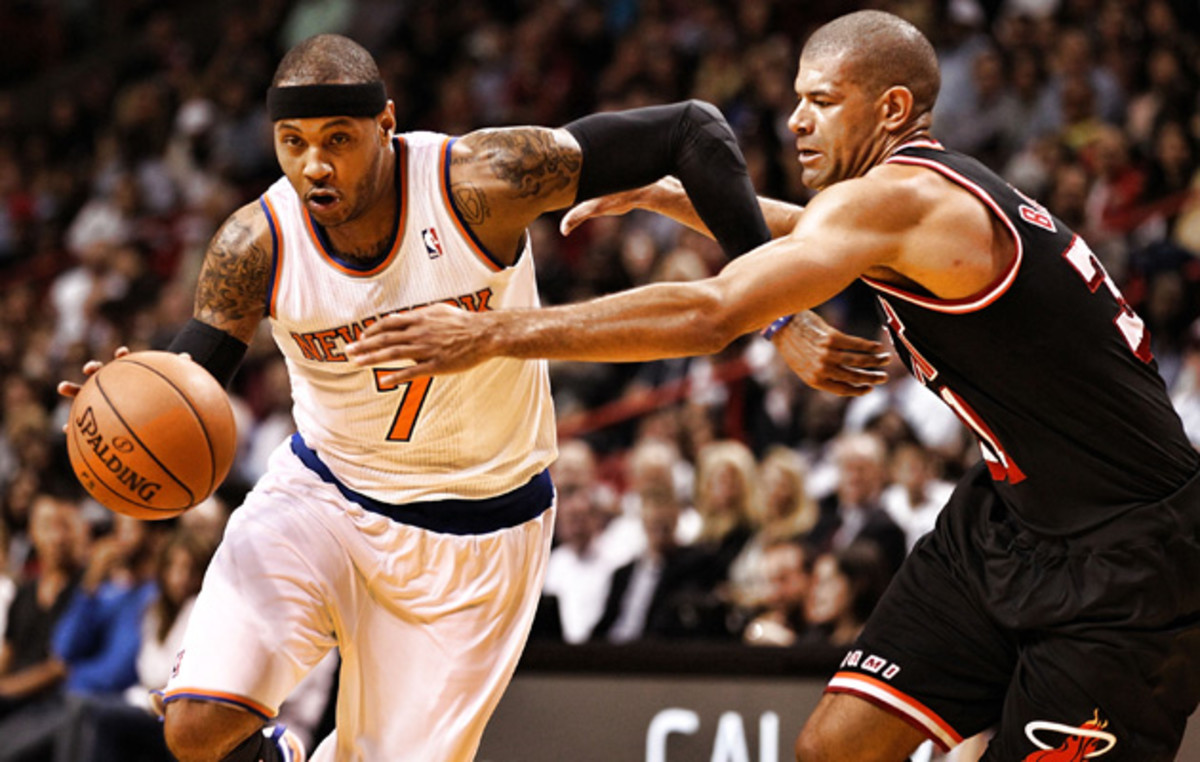
4.The smartest players Battier ever played with: LeBron James, Tracy McGrady and Yao Ming.
5. Jeff Van Gundy on his brother Stan waiving Josh Smith from the Pistons: 'Stan has steel balls.' That quote brought the house down at Sloan, but a moment at a different panel showed that Stan’s testicles aren’t his only body part made of something strong. A research paper titled “Graphical Model for Basketball Match Simulation" revealed that if the Josh Smith-less Pistons played the Josh Smith-led Pistons, the former would win 64 out of 100 times.
6.Numbers told the Rockets to play Yao Ming 48 minutes per game. Obviously, they didn’t, but Morey said analytics indicated, “a tired Yao was better than anything we have.” Morey and Van Gundy used to discuss various strategies all the time and how they could incorporate analytical findings. When Morey once back-pedaled on one discovery, Van Gundy called him out: “You either believe this s--- or you don’t!”
[daily_cut.NBA] 7. The 2-for-1 debate is a waste of our time. One of the topics Morey and Van Gundy used to go back-and-forth on (oh, to be a fly on that wall) was JVG’s refusal to try and get two shots at the end of a quarter instead of one. Statistics told Morey that it was wiser to take two bad shots than one good one, but Van Gundy still preferred the latter. Eventually, Van Gundy asked Morey how many more wins the Rockets would total if they did, in fact, utilize the strategy. Morey crunched the numbers. The result? About one victory every two years.
8. “If you lose now, it’s called a plan.” Van Gundy, at his best, speaking the truth.
9. Can the triangle offense work in the NBA? Kevin McHale once told Morey: “If you have the best players, you can run the square.”
10. “When you say ‘I don’t believe the numbers,’ you’re really saying, ‘I don’t believe in the guy that’s telling me.’” That bit of wisdom came from Celtics assistant GM Mike Zarren, a Sloan mainstay and one of the most candid speakers year-in and year-out.
[pagebreak]
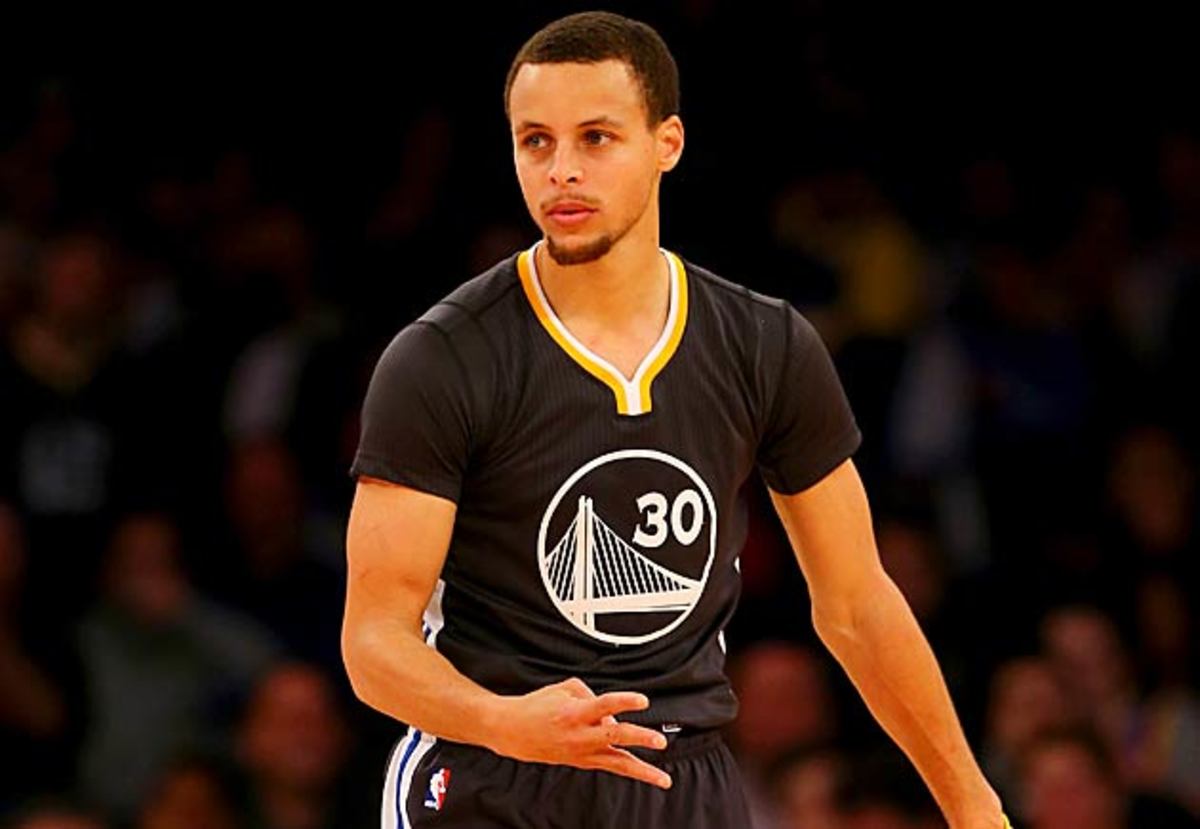
’s defensive improvement this year to exactly that.
12. Speaking of D’Antoni, he was everywhere this weekend. D’Antoni participated in the basketball panel early Friday morning, but he stuck around the rest of the weekend, sitting in the audience for a number of panels and research papers and looking genuinely intrigued. Sloan is a tremendous learning experience for anyone, whether you’re a coach or a college student. Last year, it was Steve Kerr roaming the hallways and curiously sitting in on panels, taking notes and sessions to heart. Seems like it worked out well for him.
13.Someone asked D’Antoni if coaching Carmelo Anthony was his worst nightmare. The former Knicks coach, and big advocate of ball movement, quipped: “They are doing great things with therapy, I’m good.”
14. The draft wheel resurfaces. In what’s quickly becoming an annual tradition, Zarren brought up his proposed NBA draft wheel once again. The goal of the wheel is to combat tanking and randomize drafts even further than the lottery. Here’s a photo of Zarren’slatest proposal, using two different models. For a full breakdown, check out Zach Lowe's piece on Grantland from 2013.
Celtics assistant GM Mike Zarren presents two proposed NBA draft wheels. Would combat tanking. #SSAC15 pic.twitter.com/DKz9Qa609E
— Matt Dollinger (@matt_dollinger) February 27, 2015
15. Injury prevention technology will present some interesting debates. If you want an idea of how revolutionary injury prevention technology will be in sports, read Chris Ballard’s profile of P3 from earlier this season. If you want an idea of how sensitive of an issue this is going to be once the technology becomes mainstream, take these words from WNBA star Sue Bird: “If we had injury prevention technology, would you draft Derrick Rose?” Bird said she wouldn’t allow herself to be tested out of fear of teams discovering something that would hurt her stock.
16. Basketball is transcendent content. Kings owner Vivek Ranadive preached the timelessness and value of NBA games repeatedly during the Business of Sports panel.
“In 20 years, will I still be using my iPhone?" Ranadive said. "I don’t know. But will I still be watching NBA basketball? Without question.”
No matter the technology, people will consume NBA games for decades to come.
17. The NBA’s potential for growth in India is astounding. Ranadive went to his home country in December with NBA commissioner Adam Silver and a large league contingency. Both men see the potential for the NBA in the booming country. There are more than one billion people in India, yet there isn’t a single arena in the NBA’s class or a player in the league who hails from the country. Ranadive says India currently lacks the infrastructure, but he sees development on the horizon. The belief is that India can follow in China’s footsteps (which now has 300 million people playing basketball) and become a hoops hotbed. Basketball is the largest growing sport in India.
• MORE NBA: Basketball Without Borders | Rose's injury clouds Bulls' future
Said Ranadive: “With the clinics we’re conducting, coaches we’re sending and the investments we’re making, we’ll see the same success as [we have in] China.”
Open Floor: How the Wizards lost their edge, Garnett's return and more
18. Ranadive knew NBA franchises were worth billions before Steve Ballmer bought the Clippers. Ranadive paid about $540 million for the Kings in 2012, but told fellow owners at the time that he believed these teams were worth $2-3 billion.
“People thought I was crazy,” Ranadive said. “I said it was undervalued. This is the only content that won’t time shift. Ten, 20, 30 years from now, you’ll still be watching the NBA … the audience is growing and ultimately, if you look at the value of what it is, it’s a social network. This content allows you to engage and capture and expand that social network.”
19. “Counterpoints” may be the future of defense. Get used to hearing that phrase, which Grantland's Kirk Goldsberry and Harvard's Alexander Franks, Andrew Miller and Luke Bornn introduced at Sloan. Counterpoints are “a weighted average of points scored against a particular defender per 100 possessions” and could become the way we measure defensive aptitude in years to come. To read the full paper, click here.
20. Defensive analytics are dragging behind drastically. This was one of the biggest themes from the 2015 conference. Only 10 percent of metrics apply to that side of the ball, yet it’s 50 percent of the game.
21. We’re getting closer to being able to quantify team chemistry. The “Graphical Model for Basketball Match Simulation" paper could help analysts take a big step in evaluating chemistry. The three researchers from Columbia created a model that can “bridge the gap between player identity and team level network.” The model shows the importance of which players are on the floor and how they interact with their teammates. Using their simulation, they used the 2014 NBA Finals as a demonstration of how important synergy can be. Here’s a graphic that shows you how the Finals could have turned out differently if different lineups were used.
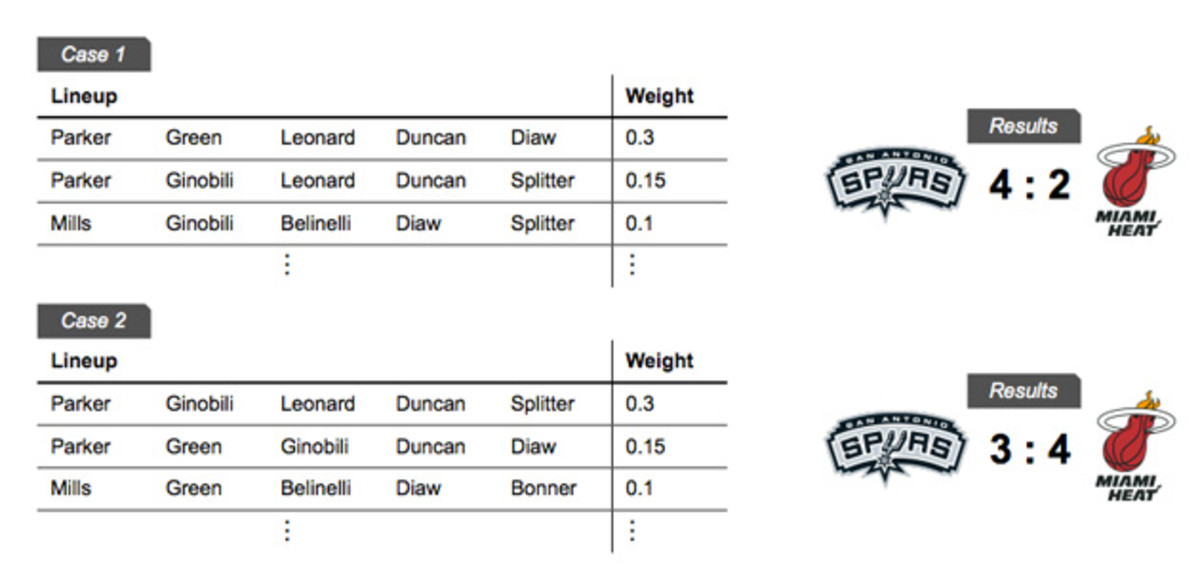
22. Corner threes are the most efficient shot and the most team-friendly. According to Goldsberry, 96 percent of corner threes come off assists.
23. “Giving Matt Bonner credit for a corner three is like giving Javier Bardem credit for No Country for Old Men.” He deserves some of the appreciation, but not all of it, Goldsberry humorously argued. I don't care how long it took Goldsberry to come out with that joke, I loved it.
24. Roy Hibbert disrupts shots, Dwight Howard deters them. There are two very different ways to dominate. Goldsberry highlighted “The Dwight Effect” at last year’s Sloan Conference, explaining that Howard’s block numbers aren’t reflective of his dominance due to his ability to completely deter opponents from shooting against him. Hibbert, meanwhile, faced the most attempts of anyone in the league last season, contesting 41.9 percent of shots while in the floor. To give you an idea of how Indiana's defense works, Hibbert's backup, Ian Mahinmi, ranked third on that list.
25. Opponents do not shoot when Chris Paul is guarding them. The Clippers star faces the fewest attempts of anyone in the league, according to Goldsberry, and reduces shot frequency from every spot on the floor. In contrast, James Harden faces the most attempts of any wing defender in the league. To give you an idea of how dominant Paul is defensively, Goldsberry compared him to Deron Williams in this visualization. The colored dots display the frequency of opponents' attempts.
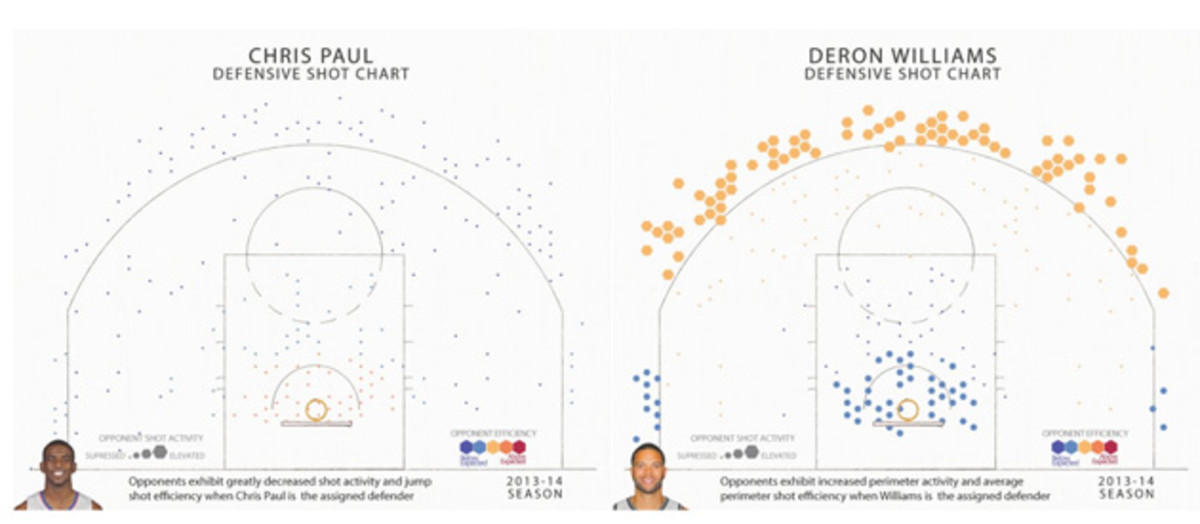
26. Paul allows the fewest points of any backcourt player in the NBA. Who is on the opposite side of the spectrum? The Pelicans’ Jrue Holiday, who edges Shaun Livingston, Jarrett Jack and Mo Williams. The best wing defender using the same metrics, surprisingly, is Mike Dunleavy while the worst is Jodie Meeks.
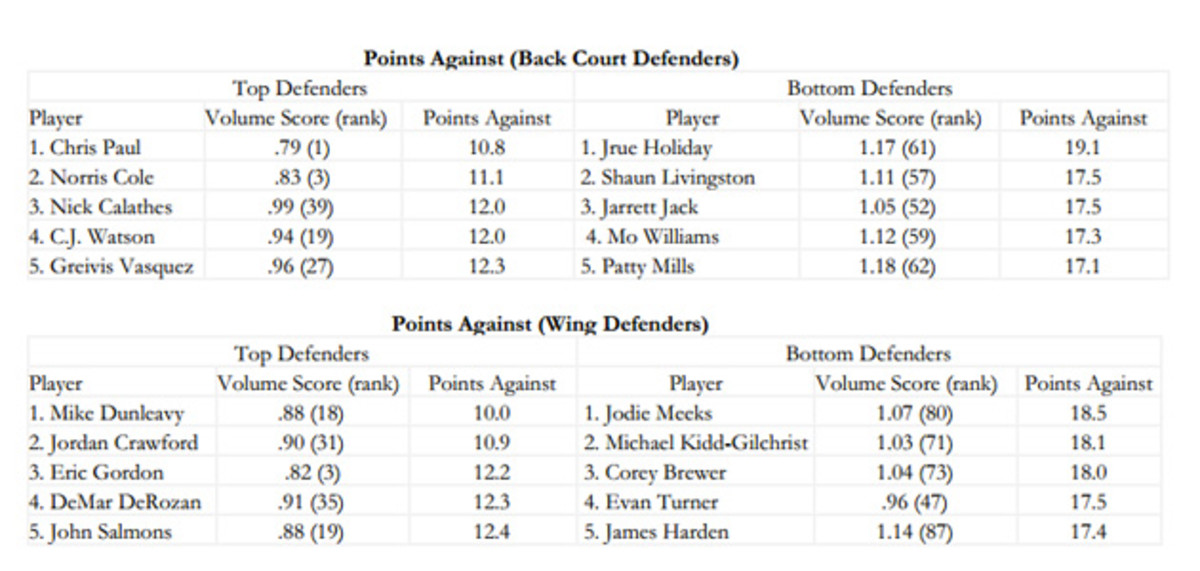
27. The lack of access to NBA data is likely preventing major breakthroughs. Goldsberry said the lack of access is “one of the biggest frustrations from my contemporaries.” The Grantland scribe explained that analysts have more access to data than ever, but there’s still a huge gap between what we know and what teams know.
“I do think the NBA should do some soul searching about its access,” Goldsberry said.
28. The most staggering NBA stat from Sloan? Fouling when winning can increase your chances by 11 percent, according to a paper written by Franklin Kenter of Rice University. The paper shows that fouling near the end of games pretty much makes sense in every situation, whether you’re trailing or leading. When behind, it advises fouling one minute out for every six points you are behind. When leading, it suggests fouling one minute out for every three points you lead.
29.Kevin Durant has an average of 1.2 people guarding him at all times. Or in other words, Goldsberry said, he’s double-teamed 20 percent of the time he’s on the floor.
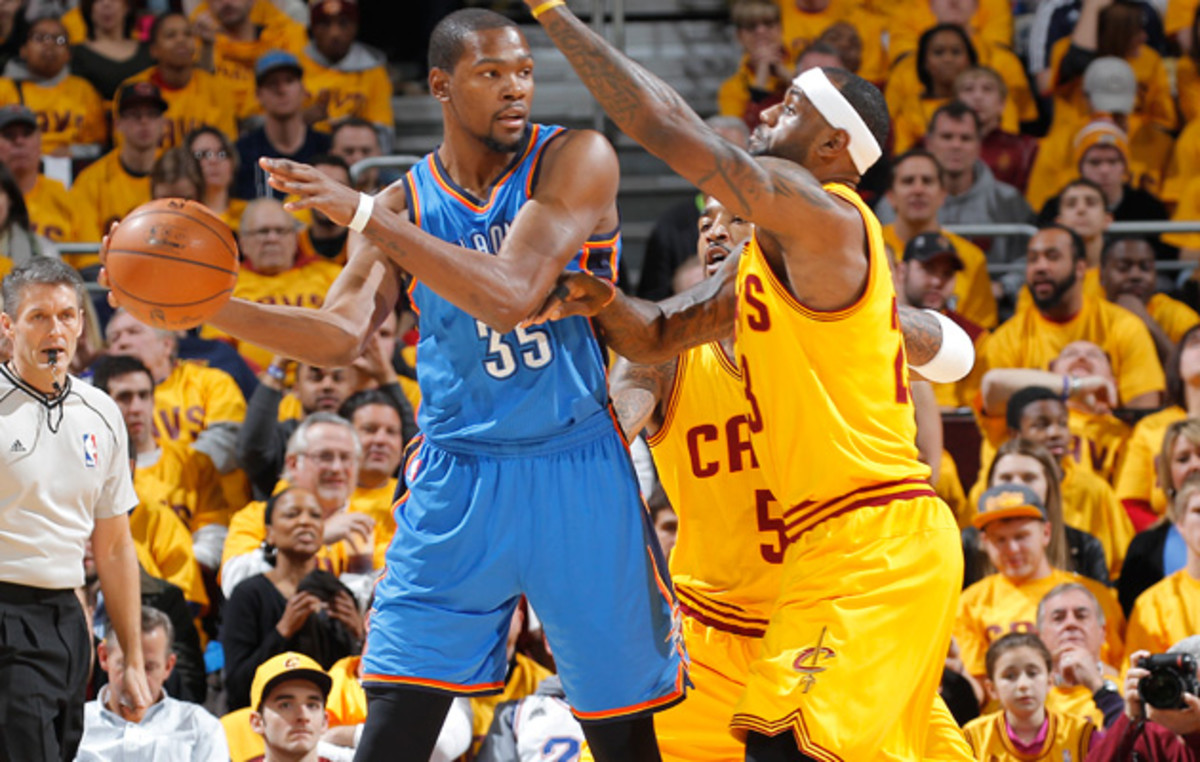
30. Why doesn’t the NBA crack down on people ripping highlights and putting them on YouTube? NBA commissioner Adam Silver explained: “Highlights are marketing.” Stealing highlights isn’t anything new. Silver said long before the NBA was in business with ESPN, SportsCenter used to steal its highlights all the time under news access rules and the interpretation of the first amendment.
“We’re incredibly protective of our live game rights, but for the most part highlights are marketing,” Silver said.
The commissioner said he would love for Twitter users to one day be able to click a button and purchase a game if they feel compelled after seeing a highlight.
[pagebreak]
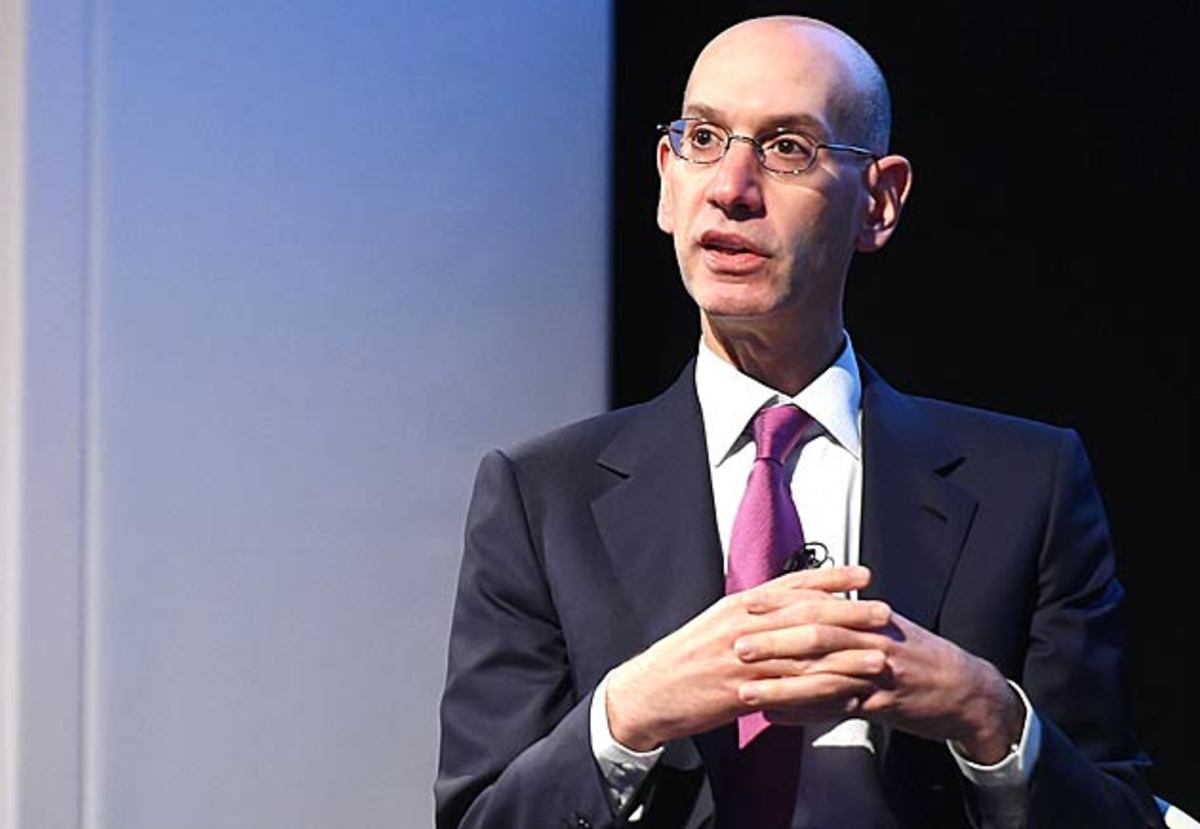
Due to cable restrictions, the only way to purchase NBA games is by buying the right to watch an entire season through League Pass. But Silver envisions a setup where fans can buy games individually.
“Most people don’t want to consume that many games,” Silver explained.
32. Silver is watching your tweets. We can only speculate as to what his Twitter handle might be, but it’s clear Silver keeps a close eye on all of us.
“The snarky, comedic aspect makes it fun,” the commissioner said. “There are certain people you can count on to react, much like the personalities of season-ticket holders in a section at an arena," he explained.
33. The NBA is lucky to have Silver. There isn’t a more progressive commissioner in all of sports. Whether it’s his views on sports gambling, tanking, scheduling, television, the game itself or myriad of other topics, Silver is listening to your ideas and considering everything under the sun. It’s that type of open-mindedness that’s led to his success since taking office 13 months ago and has so many people believing that the NBA’s best days are yet to come.
34. Data offers little help in NBA contract negotiations. The reason? Neither side trusts each other. Numbers can be used to support a player or tear him down, which is why they are very rarely the crux of contract talks. In baseball, where there is arbitration, numbers are relied upon heavily to settle disputes and peg a player’s value, but the same is not the case in the NBA.
While You Weren't Watching: Dragic fakes, Conley sneaks, and more
35. The tricky relationship between analytics and superstars. You don’t need data to tell you that you need one of the top 10 or 20 best players in the NBA to win a title. When McGrady and Yao left Houston, Morey found himself in need of a superstar. The Rockets weren’t bad enough to land a top draft pick and were unlikely to lure a star to Houston due to the fact that there wasn’t one already in town. So Morey turned to trades. He pored through data, looking for undervalued players.
So then he traded for James Harden, right? Wrong. At first, Morey believed Terrence Williams was his hidden gem. But that experiment ultimately failed, which led the Rockets to chase after Harden, who was the sixth man for the Thunder at the time. When meeting with ownership, Morey stressed the importance of acquiring a top talent like Harden.
“We should just give them everything,” Morey said.
36. NBA GMs are more likely to do deals with their friends. If you noticed a pattern in trades in recent years, you’re right. Warriors GM Bob Myers conceded that people in his role are more likely to call up a friend or former co-worker when looking to make a deal.
37. Defensive analytics will help role players get paid. Shane Battier was an undervalued player until Michael Lewis profiled him in the New York Times, calling him The No-Stats All-Star. But the days of players like Battier slipping under the radar are numbered. As defensive statistics become more sophisticated and more prominent with NBA fans, specialists like Battier and Tony Allen will be easier to quantify as valuable players. Once they are recognized in easy-to-digest statistics, they’ll be paid what they are truly worth.
• MORE NBA: Rockets thriving without Howard | Harden, an unlikely MVP
38. Half of the contracts in the NBA involve no negotiating. Legendary agent ArnTellem pointed out this fact. With rookie deals, minimum contracts, mid-level exceptions and max deals, Tellem estimated only half of the deals in the NBA are bargained. He added that the most difficult contracts to negotiate are for valuable starters who are not perennial All-Stars. Draymond Green, anyone?
39. The over/under on nationwide legalized sports gambling is 4 1/2 years. That was the number the "Book It: Legalizing Sports Betting" panel agreed upon. Said Jeff Ma, the inspiration for the book Bringing Down The House and the movie 21: “It’s scary to me to think about all of the things that need to happen.”
40. A new way to explain international growth in the NBA. Spurs GM R.C. Buford, who was honored with Sloan's lifetime achivement award, said a big reason why 25 percent of the league is now composed of international players is because the U.S. developmental programs for youth players are “far behind” what’s going on overseas.
41. LeBron’s contract is one of the biggest inefficiencies in sports. As Nate Silver pointed out, LeBron’s max contract gives his team a huge edge on the rest of the league due to his true value. If you play daily fantasy, LeBron can take up two-thirds of your cap room. But on the Cavaliers, he occupies roughly one-fourth.
Jimmy Butler: Running The Gauntlet
42. No one in the tanking discussion is claiming players aren’t trying. I just want to reiterate that point after listening to Brian Burke and Falcons assistant GM Scott Pioli come off like dinosaurs during the "Future of The Game" panel at Sloan. Burke and Pioli repeatedly went to the same well, claiming that if players or coaches aren’t trying they should be banned from sports.
No one is arguing that! No one thinks the 76ers' players and coaches aren’t trying. No one thinks Brett Brown is calling the wrong plays. No one thinks Nerlens Noel is purposefully missing shots.
Tanking is setting up your franchise to fail—it’s not purposefully throwing the game. Players and coaches have zero incentive not to give 100 percent. This is a concept that most of us have been familiar with for years, but Burke and Pioli haven’t appeared to get the memo.
As Buford, a man with a good head on his shoulders, explained: “I know the coach in Philadelphia. I know the players. I don’t think any of those guys are going out on a nightly basis and trying to lose.”
• MORE NBA: Big Board | Kerr changes Warriors | Trade deadline trends
And if you’re upset with tanking as a whole, which is a fair complaint, you should blame the leagues. The current setup in the NBA makes tanking a legitimate, and sometimes, wise strategy. If the Lakers win too many games down the stretch, they have to give up their 2015 draft pick. Wouldn’t you say it’s in their best interest to play the young guys and prepare for next season?
Said Buford: “It’s a strategy that’s allowed within our rules … I don’t think it puts our game in a great light.”
43. The path of a basketball during an NBA game. This is just awesome.
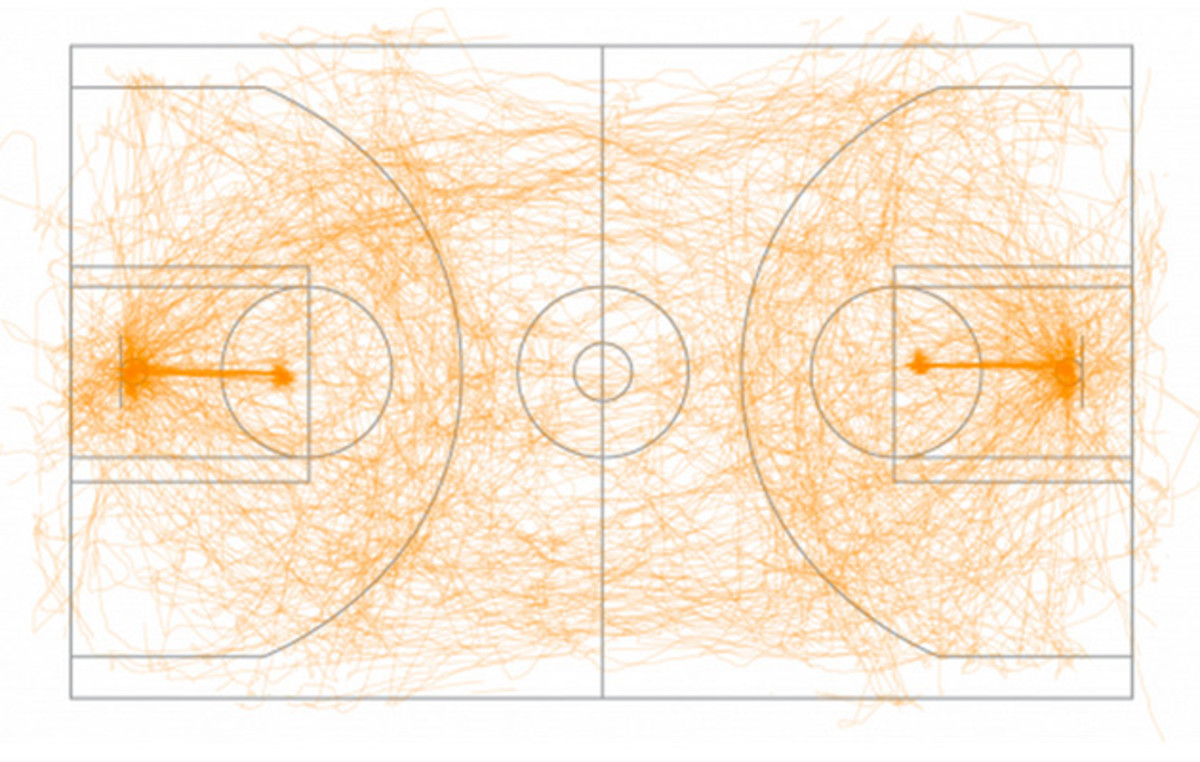
44. The path of Tim Duncan during an NBA game. Not a lot of inefficient movement from the Spurs' stars. Compare his chart to Thabo Sefolosha’s and you get an even better sense of Duncan’s calculated motion.
Tim Duncan
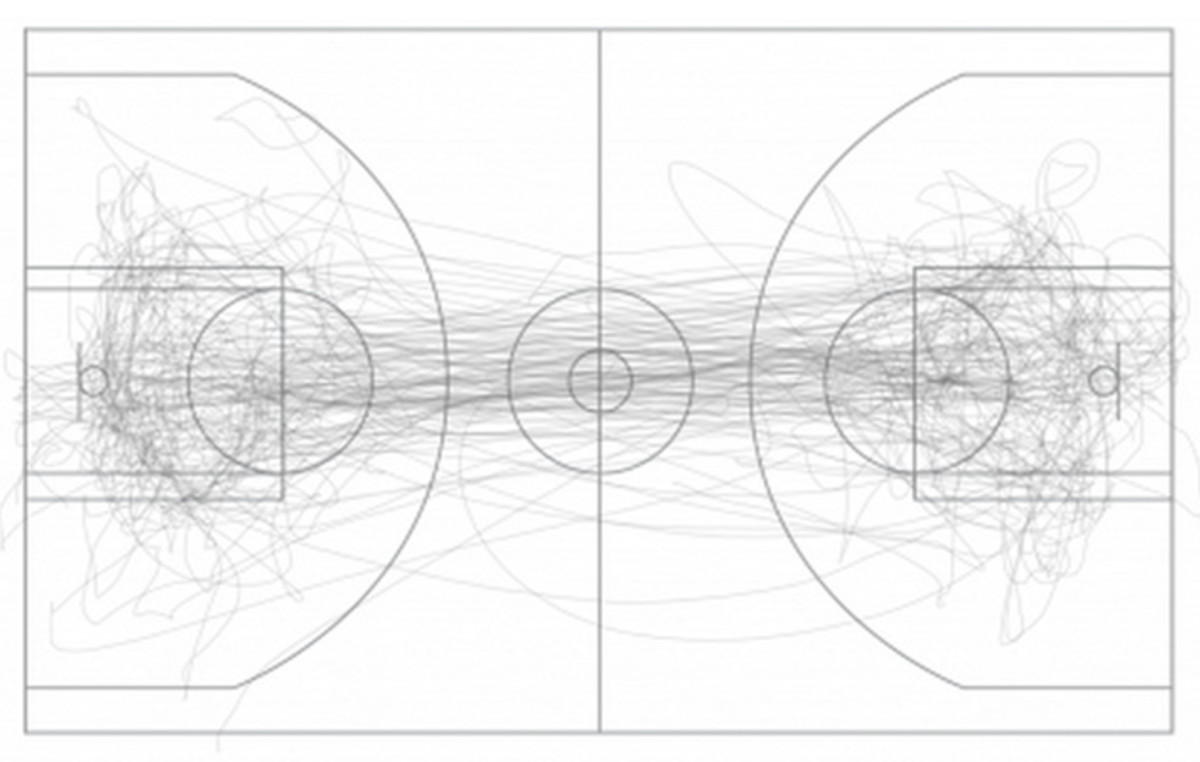
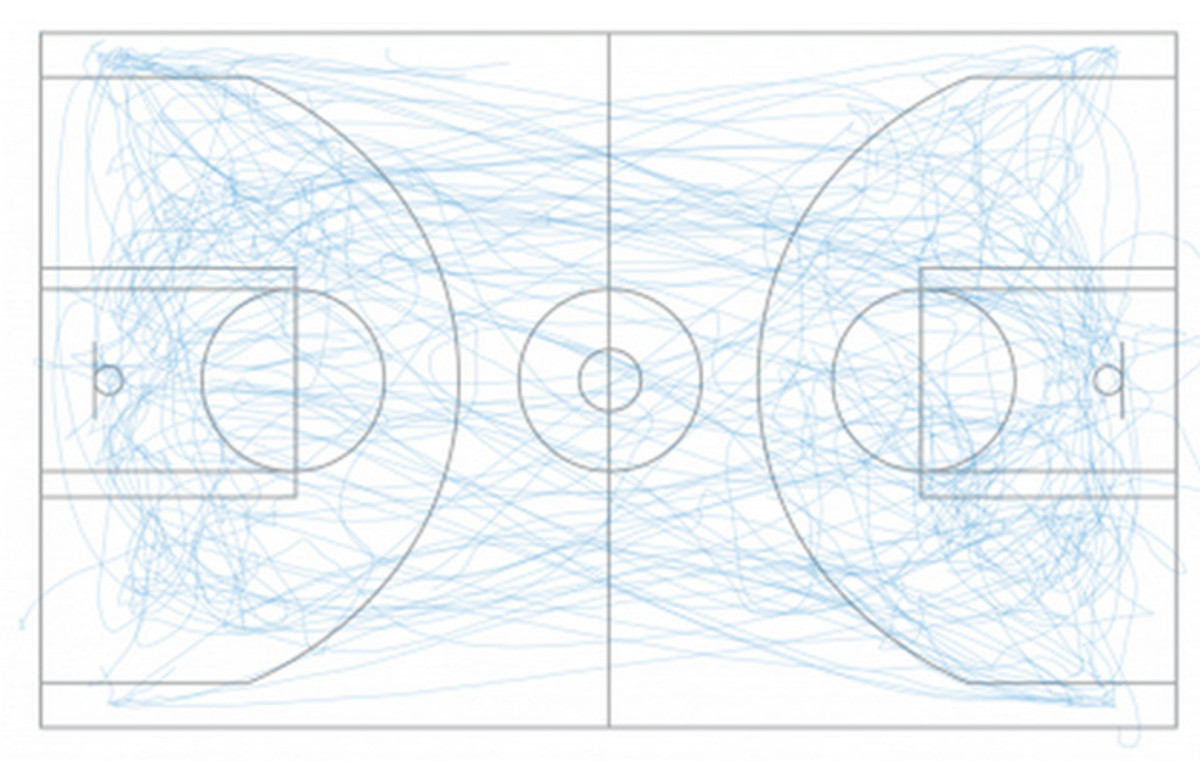
45. The best sports writing blends analytics. This is a point Goldsberry made that I couldn’t agree with more. The most intriguing, informative stories combine analytics, storytelling, quotes, videos and visuals together. If you’re too reliant on any one of those characteristics, the piece comes off as incomplete.
46. The next PER. Much like Player Efficiency Rating has become a relatively common metric, Expected Possession Value (which Goldsberry debuted last year at Sloan) could soon become the next household stat. Goldsberry’s new statistic measures the likelihood of points from any spot on the floor during any moment in the game. Here’s an example of a Spurs possession:
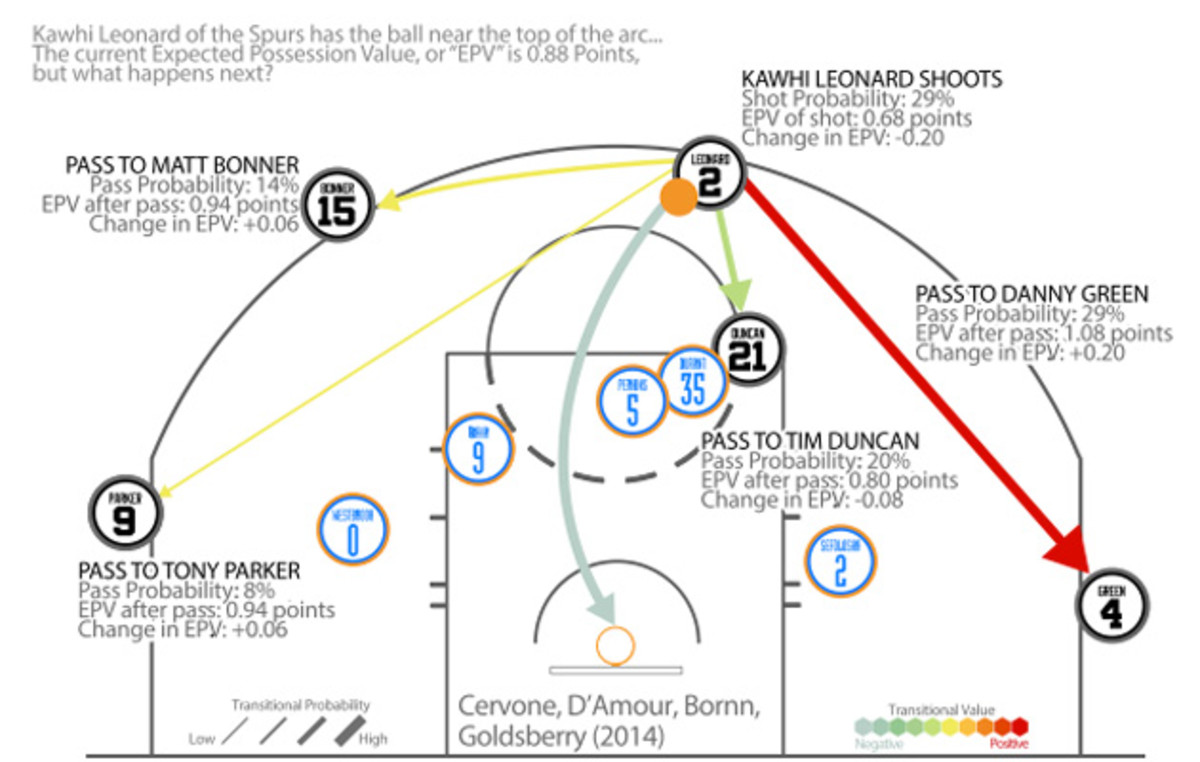
47. The NBA squeezes 82 games into 170 days—one of those numbers isn't changing. There’s simply too much money on the table for the NBA to realistically reduce its number of regular-season games. But that doesn’t mean the league isn’t exploring innovative ideas to make the rigorous schedule easier on its players. We’ve seen that with games slightly less clustered this season and an extended All-Star break, as well.
Silver realizes this is a problem with the league and gave Gregg Popovich a tip of the cap when asked about the criticism the Spurs coach faces when he rests his starters.
"Maybe he's right," Silver said.
48. “Data does not equal analytics.” An important quote to remember from ESPN’s Ben Alamar.
49. The believer vs. non-believer debate is getting out of hand. We can probably give Charles Barkley a hefty share of the blame for this one. This was pointed out several times during the conference, but maybe most notably by Van Gundy. Analytics aren’t so black-and-white that you can say some people use them and some people don’t. It’s not that simple. There are varying measures of belief, just like anything else. On top of that, there are varying definitions of analytics.
• MORE NBA: Barkley on his feud with Morey | Barkley talks NBA analytics
Here's Goldsberry's definition: "Reasoning artifacts. Products of analysis that enable us to understand something we didn’t understand."
50. “Analytics help me sleep better at night.” Mike D’Antoni’s offense was revolutionary in Phoenix, but it wasn’t because of some vast statistical discovery. The head coach said that analytics reaffirmed a lot of what he believed, but didn’t necessarily dictate his scheme. This was a theme echoed throughout Sloan, and one that I think is good to end on.
As Battier said on Friday: "Analytics are a tool, just like a jump shot or strength training."
